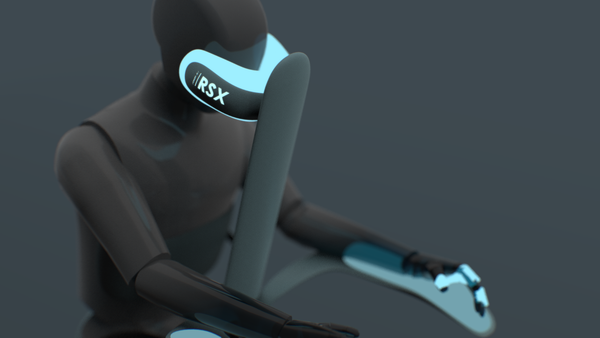The Future of Virtual Reality in Product Design
Virtual reality is beginning to prove itself as a useful, innovative, and collaborative design tool.
December 21, 2020

The pandemic has been a surprising innovation force in all areas of design engineering, from advanced manufacturing developments through product design. Oddly, many remote design teams have become more efficient and more creative than their office-based counterparts. Cormac O’Conaire, creative director at Design Partners, spent time with Design News to explain how virtual reality (VR) has come of age as a design tool during 2020.
Part of the advancement in VR as a design tool comes from ongoing advances in the software and hardware delivered by VR vendors. Yet another part of it comes from the necessities of remote teamwork. “Over the years, our team at Design Partners has designed experiences for AR and VR for various applications from healthcare to gaming, but over the past nine months, we've been experimenting with VR in its capability in the design process,” O’Conaire told Design News. “We’re seeing the potential of VR to change the design industry, and more fundamentally, the way we create new ideas.”

A Mix of Surgeons and Gamers

VR technology has advanced in its ability to serve the oddly similar needs of surgeons and gamers. That technology can also be put to use in product design. “Surgeons and gamers share some important qualities – an appreciation of precision and accuracy, visual-spatial skills, depth perception ability, total immersion in a task,” said O’Conaire. “Using a simulation of the human body, VR was used to study the human factors and ergonomic issues of existing solutions in a three-dimensional environment. The body’s posture was then optimized using Gravity Sketch’s mannequin and the ideal future controller was built around that human form.”
The virtual world is ripe for simulation, which helps make the technology appropriate for design. “Whether it’s an operating room, an outdoor environment, or the view from a crane, we can simulate the context and experience the customer journey in the virtual world for which we are designing,” said O’Conaire.
Developing VR Remotely
In so many instances during 2020, the remote-teams aspect of the pandemic has prompted unlikely innovations that will last beyond the lockdown. “Design teams will always adopt tools that maximize both creativity and efficiency, accelerating the ability to innovate at speed. VR as a creative tool has been a novelty until recently,” said O’Conaire. “Instigators of this shift are programs like Flyingshapes and Gravity Sketch, as well as hardware firms like Oculus and Logitech, who are innovating in the space. Then the global pandemic forced creative teams to work remotely.”
Like CAD before it, VR technology can be a shared environment, and it doesn’t matter where on earth the team members work. And the VR environment beats Zoom. “Virtual Reality allows creative teams to connect remotely in a more natural way than staring at Zoom’s rectangles. An unexpected benefit of VR is the relaxed meeting room vibe it creates,” said O’Conaire. “You can look over someone's shoulder on their creations and thought process, or work in your own space within the virtual environment. In these COVID times, this feels both refreshing and liberating. It makes for an immersive, warm, and collaborative experience.”
Like advanced CAD, the VR designs can be tested and validated before they enter the physical realm. “Instead of prototyping large-scale concepts, objects, or environments – costly and time-consuming – you can simply mock them up in VR,” said O’Conaire. “You can simultaneously design and validate workflows and ergonomics in real-time.”
The Ups and Downs of VR Hardware
O’Conaire noted that VR hardware lags in development. While recent advances have been impressive, the hardware still needs to grow. “Despite its incredible promise, VR hardware is still letting us down. The latest Oculus Quest 2 is heading in the right direction, but in general, the headsets are still too bulky and cumbersome, adding friction to the creative process,” said O’Conaire. “Also, the standard VR controllers are not quite intuitive enough to dive right in and start creating. There is a learning curve required that is not natural.”
While the lag in hardware advances stifle the design process to some extent, advances that did come along have helped. “There are some advances in hardware that have made the design processes easier. We have used Logitech’s VR Ink Pilot Edition since lockdown began and found that it turns strange and alien interactions into a more natural experience,” said O’Conaire. “The pen uses familiar paradigms of design – pen, and paper – and translates them into the virtual world. This speeds-up the learning curve in the VR software and helps get into the flow of design quicker.”
Logitech’s system provides a smooth transition from 2D sketches into 3D development. “Part of its magic in Logitech’s Flyingshapes is the VR Ink pen lets you use a flat surface for 2D sketching. This is second nature for designers, but it's something standard controllers can’t do,” said O’Conaire. You can create in 2D on a physical surface and then pull the design into 3D and design in the air. This new way of creating will accelerate the design process making it more efficient in bringing a product to market.”
From a design perspective, VR technology has become an effective way to turn doodles into sketches into 3D designs into validation and prototyping. “Designing and creating in virtual realities has become much more appealing for creativity, prototyping experiences, and collaboration,” said O’Conaire. “In the early stages of the design process, VR is like a turbocharged sketchbook, giving the capability to doodle ideas and explore them in three dimensions. We can create sketches, surfaces, and forms in a kind of infinite three-dimensional space. You can weave forms together like clouds, without worrying about precision and accuracy, almost as freeform as your thought process.”
The Future Waits for Software and Hardware Developments
O’Conaire points to advances that are still needed for VR to become a full-fledged effective design tool:
More intuitive and familiar interactions – new hardware controls and interactions to support sketching, sculpting, prototyping, animating ideas (e.g. ARI).
Less bulky - slim & lightweight. Considerate of human factors and ergonomics for creative use over extended periods. (HTC Vive is excellent but extremely heavy, tethered, and cumbersome over long creative sessions.)
Instant – remove the barriers to jump in. This is the link between hardware and software user experience.
Involve the creative community in the product development process to inspire community-driven solutions (just like Flyingshapes and Gravity Sketch are).
VR connecting with future prototyping. Perhaps the biggest future advantage of VR will be the way it can enable designers and engineers to be less constrained by what is possible. Product design usually centers on the question, “How do we manufacture this?” Yet the very fluid nature of VR creativity, coupled with 3D printing, means that we may no longer need to jump through the conventional hoops or navigate around the same constraints.
Even with the need for further developments in VR technology, O’Conaire is bullish on the future of VR for design purposes. “Why are the digital tools designers use to create future experiences the same tools project managers use to fill in planning templates, or accountants use to populate spreadsheets?” asked O’Conaire. “The VR creativity space is ripe for innovation. Certainly, having seen and experienced the power of VR, we’re going to continue to experiment and develop fluency in this space.”
Rob Spiegel has covered automation and control for 19 years, 17 of them for Design News. Other topics he has covered include supply chain technology, alternative energy, and cybersecurity. For 10 years, he was the owner and publisher of the food magazine Chile Pepper.
About the Author(s)
You May Also Like





